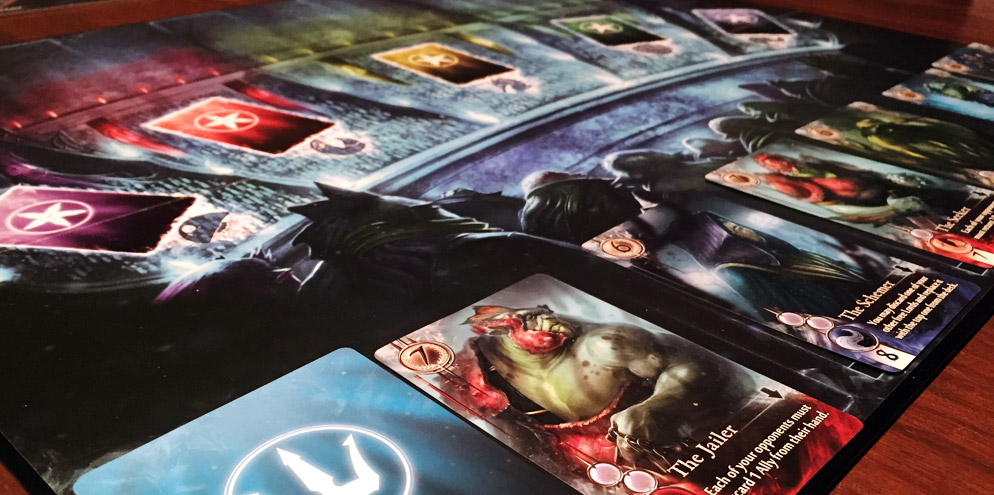 The throne is vacant. No not the Iron Throne (although that seems to happen often with that chair…). It’s the one that lies at the bottom of the ocean. The King of the Abyss has died, or maybe retired (were not 100% sure), and a successor must be found. Using your cunning, skill, and maybe a little bit of luck, you could be the next to claim the throne and become the king of the Abyss.
The throne is vacant. No not the Iron Throne (although that seems to happen often with that chair…). It’s the one that lies at the bottom of the ocean. The King of the Abyss has died, or maybe retired (were not 100% sure), and a successor must be found. Using your cunning, skill, and maybe a little bit of luck, you could be the next to claim the throne and become the king of the Abyss.
That’s the theme behind today’s review of Abyss, a eurogame designed by Bruno Cathala (5 Tribes, Shadows over Camelot) and Charles Chevallier (Sultaniya), and published by Asmodee Games. Is this game of undersea strategy just a pretty face or does it have what it takes to earn a spot on your gaming shelf? Let’s find out!
Abyss is a hand management and set collection game for 2-4 players that takes about 45-60 minutes to play. Abyss plays best with 3-4 players.
Game Overview:
To become the new King of the Abyss, you have to acquire the most influence points (victory points). Influence points are gained in a variety of ways from allies, lords, and locations. You can also earn influence points by slaying the great monsters that patrol the depths.
Abyss really takes place on 3 levels. First, the players must recruit ally cards, either via the games exploration mechanic or by requesting their support in the council. Once a player has enough allies, they can use them to recruit a powerful Lord. These Lords come with special abilities and sometimes keys to the city. Acquire enough keys and you can take control of a location, earning you extra influence points. The game ends when enough Lords have been recruited, at that point, the player with the most influence points wins.
Game Components:
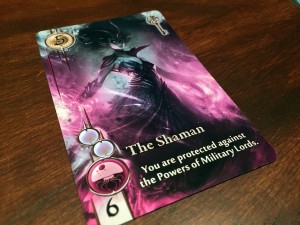
I can talk about the different types of cards, the game board, or the various tokens that come with the game, but the first thing that is going to hit you in the face is the absolutely STUNNING artwork in Abyss. Artist Xavier Collette did an amazing job with his illustrations. From the second you open up the box (which comes in 5 different covers), you are greeted with a variety of highly thematic visuals. From the variety on the Lord cards to the excellently illustrated game board (that shows the council chamber), I just loved everything about the artwork in Abyss. This is easily one of my favorites to come out in a long time.
Reluctantly moving on, the other component of note are the pearls. Yes, the game comes with actual pearls. Well not real ones, but fake ones and little containers to hold them in during the game. I actually thought this was a nice thematic touch. While they can bounce around the room if misplaced, I enjoyed using them as the game currency and felt it was a nice thematic touch. High marks to Asmodee for going all out with the production of Abyss.
How to Play:
Learning how to play Abyss should be fairly simple. Once all the various decks are shuffled and the game is setup, you are ready to begin.
Each player will take their turn in order, going clockwise from the start player. Each turn takes the following 3 steps:
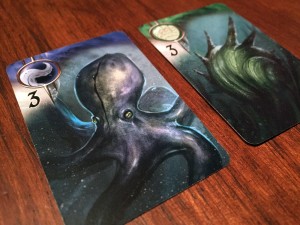
1. Plot the Court (optional): You may spend a pearl to add a Lord to the court (if there are open spots).
2. Take One Action: Players must take one of the following three actions.
- Explore the Depths: Draw ally cards, one by one, from the exploration deck and place them face up on the board. As each card is drawn, the other players may purchase them from you with their pearls. If no one buys the card, you may take it into your hand, ending your action. If you decide to pass on the card, you may keep drawing cards (and offering them first to other players), until you get to the end of the exploration track. In that case, you must take the last card, but you also gain a pearl.
If you draw a monster card, you can fight it (ending your turn) or discard it and keep drawing. Any cards not chosen are placed in their appropriate pile in the council chamber spot on the game board. - Request support from the council: Choose any of the 5 council decks and take all the cards into your hand. These are all cards that were passed over during previous exploration actions.
- Recruit a Lord: Purchase one of the face-up Lord cards by discarding ally cards equal to the purchase cost of the Lord. Some Lords require specific color allies to be recruited. Most Lords have powers that may immediately be used by the player. Some also have keys which can be used to gain control of locations.
3. Control Locations: As soon as you have 3 keys from your Lords, you MUST take control of a location. You choose one to take from the locations stack and add them to your play area, covering up the special abilities of the Lords used to control it. The Lords no longer have their special ability, but still provide influence points at the end of the game. The location you control will provide you with an additional way to gain influence points at the end of the game.
When you have finished your mandatory actions, your turn ends and the next player to your left goes. The game ends when either any player has either recruited their 7th Lord or the Lord court needs to be refilled but can’t. At this point, the active player finishes their turn, each other player gets one last turn, and everyone counts up their influence points. The player with the most wins.
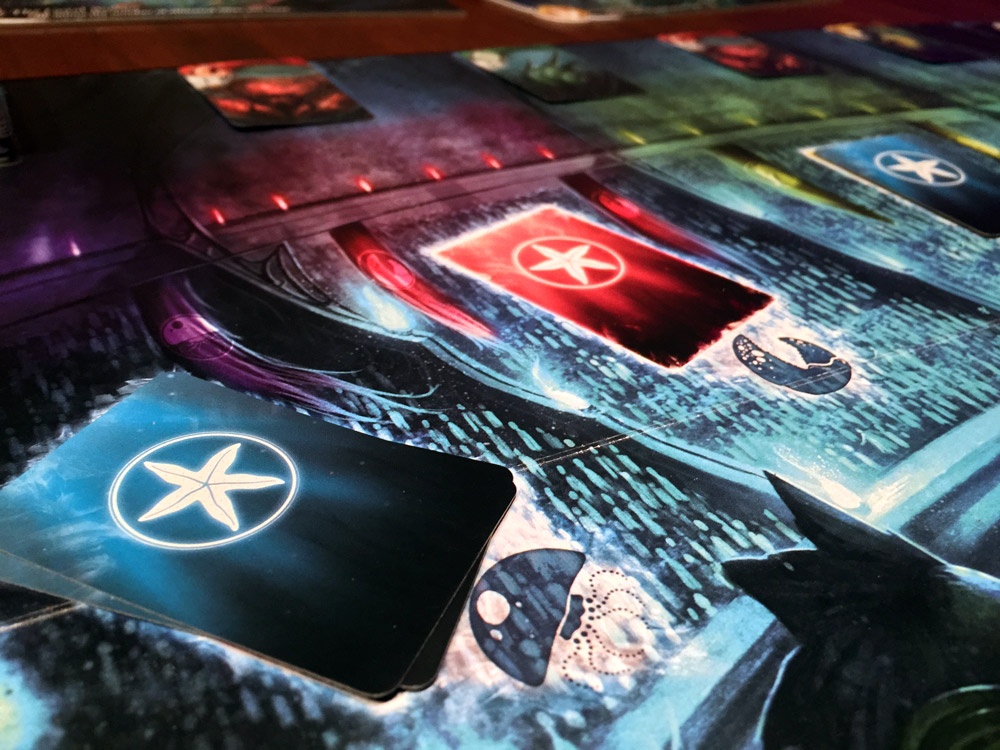
Game Experience:
Abyss has grown on me since my first impression when I thought it was just OK. Since then, I’ve played it many times and have come to absolutely love this game. Abyss combines its fantastic artwork with really solid mechanics that ended up really appealing to me. The rules are easy to teach, the game is allot of fun, and the length feels just about right.
One of the great things I like about Abyss is the interesting dynamic between the interactions of all the components. The main action you will be taking will be exploring for the ally cards. Eventually you will get enough of these allies to buy a Lord card, which is what you really want. The Lords in turn, will help you out for a while until you acquire enough keys to control a location. So that is almost an engine building (but not quite) aspect to the game.
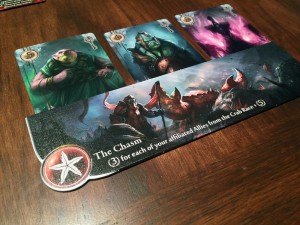
I say not quite because once you control a location, the Lords you used to get it lose their special power. This was an interesting decision because on one hand, it stops a player from abusing a Lords power (and there are definitely some powerful ones, especially the red offensive ones), but on the other hand, it almost acts as a catch-up mechanic since when you gain control of a Location, you are gaining a decent amount of influence points.
Speaking of the Lords, I felt that there was really a nice variety in their abilities and I liked how they all fit into their own category. For example, the red Lords are all soldiers who have abilities that work against your opponents. The purple Lords are mages that help you work with the ally races, while the yellow Lords are farmers that are just worth extra influence points. They all felt different and useful in their own right. Players could focus on one type of Lord if they had a specific strategy they wanted to try out. This helps give the game a lot of replay value as each game seems to play out just a little differently. This is especially true do to the 20 different location tiles. You will most likely only see a fraction of those in any game.
One of the great parts about Abyss though is the player interaction. The way the exploration was done was a fantastic way to keep players involved in the game, even when it’s not their turn. Each player can buy a card (if they have the pearls) from the person drawing them. This keeps players attention on the game even when it’s not their turn. Another interesting aspect of spending pearls is that cards are offered to players clockwise from the active player and each card purchased raises the price for the next player by one pearl. Sometimes I’d buy a lower value ally card for one pearl, just to block my next opponent who I knew couldn’t afford to buy a card for two pearls.

The press-your-luck mechanic with the exploration was also a nice touch. When 1s and 2s come up, they almost all get passed on (except in the above example when I’m trying to screw over my opponent). However, if the player drawing fills up the exploration track, they will be stuck with the last card they drew, even if it’s a 1. But what’s really interesting is that all the cards that are drawn, but not chosen, get dumped into the council piles. That means that if you pass over a lot of blue cards, you are setting up your opponent for the option to draw hand full of blue cards from the council deck. I love this little double edged sword when it comes to exploration. You definitely have to be mindful of how many cards you draw, especially in the games with a higher player count.
Speaking of the player count, I want to touch on the scaling aspect of Abyss. While I think this game works well with all player counts, I feel like it really needs 3-4 players to shine. With 2 players, the exploration loses a lot of its interaction and the council decks fill up less frequently. Since one of the fun dynamics of Abyss is buying cards from players and spending pearls, it is absolutely more fun at the higher player counts because of this. You will also churn through the Lords and Locations faster, meaning you’ll see more of them in a game. That’s not to say Abyss is bad with only 2 players, just definitely not my preferred way to play.
Final Thoughts:
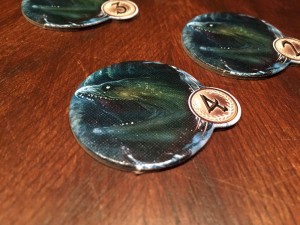
I ended up really enjoying Abyss and seemed to constantly wanting to give it another play. I know 5 Tribes was Bruno Cathala’s hit game to come out of Gen Con 2014, but I think Abyss shouldn’t be overlooked. It ended up being a really clever card game with a good mix of interaction between players and mechanics. At its heart it may just be a simple set collection game, but there is a surprising amount of depth in this medium weight game.
The artwork in Abyss is nothing short of outstanding. The components are really well done as well. The mechanics also hold up to the game’s presentation meaning Abyss will be making its way to my gaming table quite often. Unless you only ever have 2 players at the table, Abyss is absolutely worth picking up. It’s a great new card game I’ll be keeping in my gaming library for a long time.
If you’d like to get a copy of Abyss for yourself, you can pick it up for about $40.
Final Score: 4 Stars – A great set collection game with some amazing artwork and solid mechanics. This one makes its way to my gaming table often.
 Hits:
Hits:
• Stellar Artwork
• Easy to learn rules
• Solid Mechanics
• Good player interaction
Misses:
• Needs 3-4 players to really shine.
• The monster track could be more enticing.







